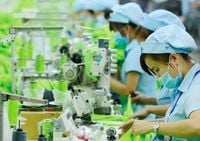As Vietnam grapples with the impact of increased U.S. import tariffs, the need for stringent controls on fraudulent product origin certification and foreign investment has become paramount. This necessity not only aims to protect domestic industries but also seeks to prevent Vietnam from being used as a tax evasion conduit. Recently, the U.S. has imposed higher tariffs on various goods from multiple countries, raising concerns among Vietnamese businesses about the indirect effects of these measures, particularly as foreign products flood into the country to launder their true origin before re-exporting.
A clear example of this is seen in Vietnam's steel industry, which, while not directly affected by U.S. tariffs, is under significant pressure from the influx of cheap steel from China. Local producers face fierce price competition and the challenge of controlling product origin, which could result in Vietnamese exports being scrutinized and potentially facing higher tariffs from the U.S. In 2024, Vietnam imported over $12 billion worth of steel from China, marking a 32.2% increase from the previous year. This trend is expected to continue as China maintains a surplus of steel supply.
This situation not only puts pressure on the domestic steel industry but also raises the risk of Vietnamese exports being subjected to stringent checks and higher tariffs by the U.S. The issue of fraudulent certification of goods' origin has previously surfaced in the wooden furniture sector, where companies imported goods from China, made minimal assembly in Vietnam, and then exported them to third countries. Such practices damage local businesses and tarnish the reputation of Vietnam's industries on the global stage.
Currently, this trend persists, particularly in the textile and footwear industries, where many Vietnamese factories are contracted to produce goods for Chinese partners to be exported to the U.S. under the label of "Made in Vietnam." The lack of stringent origin verification systems in Vietnam allows some companies to use Chinese materials in their production and label them as Vietnamese products. If this situation continues, Vietnam risks being viewed merely as a production base facilitating the mislabeling of goods, leading to stricter tariffs on its exports to the U.S. and potentially harming the economy in the long run.
Pham Quang Anh, General Director of Dony Garment, revealed that since the Lunar New Year, his company has welcomed over 20 groups of Chinese clients interested in having their products manufactured in Vietnam for export to the U.S. He noted that the number of Chinese companies visiting factories has unexpectedly increased, potentially leading to future partnerships. This scenario is not limited to Dony; other textile companies are experiencing similar trends. There is growing concern that if Vietnamese factories become the final step in the production process while most raw materials come from China, Vietnam may be seen merely as a source for re-labeling products, risking higher tariffs from the U.S.
To combat the issue of fraudulent product origin claims and tax evasion, experts recommend that the Vietnamese government tighten regulations on foreign investment, particularly from China. Reports from the Foreign Investment Agency indicate that in the first two months of 2024, China held the highest number of investment projects in Vietnam, accounting for 31% of total foreign investment projects. Dao Tien Phong, Executive Director of Investpush Law Company Limited, emphasized the importance of due diligence in foreign investments.
In early February 2025, the U.S. government signed an executive order to increase import tariffs on goods from its top three exporting countries: Canada, China, and Mexico. Under this new policy, products from Canada and Mexico will incur a 25% import tariff, while those from China will face an additional 10% tariff, effective March 12, 2025. Heavy industrial goods such as aluminum and steel exported from these three countries will also be subject to a 25% tariff. This policy could have multi-dimensional impacts, especially on countries like Vietnam, which depend on exports and are closely linked to China.
Vietnam may face an influx of foreign companies seeking to evade U.S. tariffs by relocating production to Vietnam. This shift could lead to Vietnam becoming the final production base in the supply chain, used as a country of origin to export goods to the U.S. If these practices are detected, Vietnam could face increased scrutiny from the U.S., potentially resulting in additional tariffs or stricter trade restrictions in the future.
Another potential impact on Vietnam is heightened domestic competition from cheap products flooding the market, particularly from China. As export barriers to the U.S. increase, Chinese manufacturers may seek new markets to offload their products, which could create pressure on Vietnam's domestic industries. However, as of now, Vietnam is not directly listed among the countries facing increased tariffs from the U.S., and its main export products have not been immediately affected. This situation presents an opportunity for Vietnam to attract investments from leading U.S. technology companies, particularly in the artificial intelligence (AI) and big data sectors, which could bolster its economic potential in the long run.
For Thailand, while it is not directly subject to additional tariffs, it could face indirect impacts from the situation, especially if Chinese goods are illicitly exported through Vietnam or Thailand to the U.S. to avoid tariffs. This could create unfair competition for Thai exports in the U.S. and global markets. Additionally, if the U.S. discovers that Thailand is involved in mislabeling goods' origin or serving as a conduit for Chinese products entering the U.S. market, Thailand could face retaliatory tariffs or trade restrictions in the future, adversely affecting its export competitiveness and international trade image.
Despite the challenges posed by U.S. import tariff policies, there are opportunities for Thai businesses to expand directly into the U.S. market by developing high-quality products to replace those from countries facing tariffs. Furthermore, Thailand can leverage existing free trade agreements (FTAs) and enhance product quality standards to meet U.S. requirements. The U.S. tariff measures may also encourage companies from China, Canada, and Mexico to relocate their production bases to countries not facing tariffs, presenting an opportunity for Thailand to attract investments by developing infrastructure, offering tax incentives, and targeting high-potential industries such as electric vehicles (EVs) and food processing.
However, Thailand must remain vigilant against the risks of illicitly mislabeling the true origin of Chinese products by tightening customs verification systems and educating the private sector about trade barriers. Concurrently, Thailand should focus on developing high-value-added industries such as AI, big data, and biotechnology through research and development (R&D) initiatives, attracting technology companies from the U.S., and training a skilled workforce for future industries. Additionally, Thailand should strengthen economic cooperation with countries unaffected by U.S. tariff measures, such as the European Union, Japan, and ASEAN, by accelerating free trade agreement negotiations, diversifying export markets, and fostering collaboration between Thai industries and international partners to enhance business opportunities.




